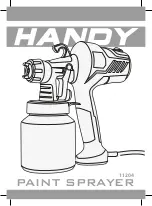
13
6. Connect the Spray Pro wire connectors to the wire
connectors located under the dash (Fig. 5).
1
2
Figure 5
1.
Connectors from the
sprayer
2.
Connectors from the
monitor
Before Operating
Checking the Engine Oil
The engine is shipped with oil in the crankcase; however,
the level of oil must be checked before you first start the
engine and after you have run it.
1. Position the machine on a level surface.
2. Remove the dipstick and wipe it with a clean rag
(Fig. 6). Insert the dipstick into the tube and make sure
it is seated fully. Remove the dipstick and check the oil
level.
1
2
Figure 6
1.
Dipstick
2.
Filler cap
3. If the oil level is low, remove the filler cap from the
valve cover (Fig. 6) and pour oil into the opening until
the oil level is up to the Full mark on the dipstick; refer
to Servicing Engine Oil, page 30, for the proper oil type
and viscosity. Add the oil slowly and check the level
often during this process. Do not overfill.
4. Install the dipstick firmly in place.
Checking the Tire Pressure
Check the tire pressure every 8 hours or daily to ensure
proper levels. Fill the tires to 18 psi (124 kPa). Also,
check the tires for wear or damage.
Adding Fuel
Danger
In certain conditions, gasoline is extremely
flammable and highly explosive. A fire or
explosion from gasoline can burn you and others
and can damage property.
•
Fill the fuel tank outdoors, in an open area,
when the engine is cold. Wipe up any gasoline
that spills.
•
Do not fill the fuel tank completely full. Add
gasoline to the fuel tank until the level is 1 inch
(25 mm) below the bottom of the filler neck.
This empty space in the tank allows gasoline to
expand.
•
Never smoke when handling gasoline and stay
away from an open flame or where gasoline
fumes may be ignited by a spark.
•
Store gasoline in an approved container and
keep it out of the reach of children. Never buy
more than a 30-day supply of gasoline.
•
Always place gasoline containers on the ground
away from your sprayer before filling.
•
Do not fill gasoline containers inside a vehicle or
on a truck or trailer bed because interior
carpets or plastic truck bed liners may insulate
the container and slow the loss of any static
charge.
•
When practical, remove gas-powered equipment
from the truck or trailer and refuel the
equipment with its wheels on the ground.
•
If this is not possible, then refuel such
equipment on a truck or trailer from a portable
container, rather than from a gasoline dispenser
nozzle.
•
If a gasoline dispenser nozzle must be used, keep
the nozzle in contact with the rim of the fuel
tank or container opening at all times until
fueling is complete.














































